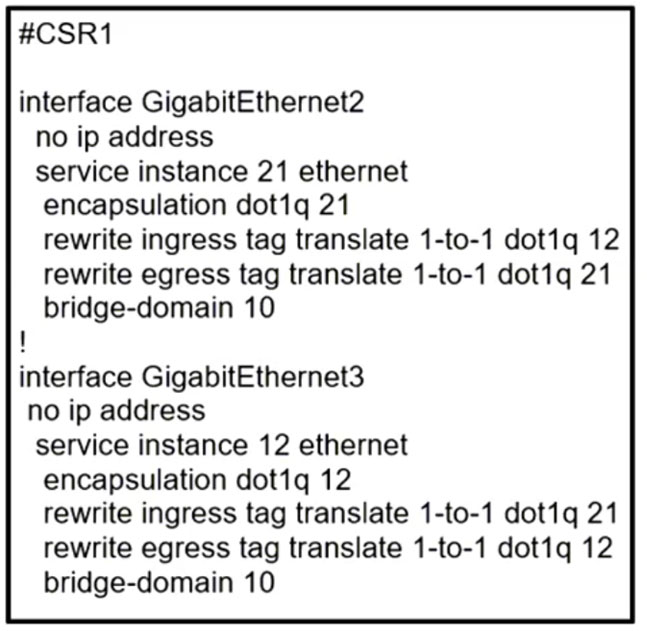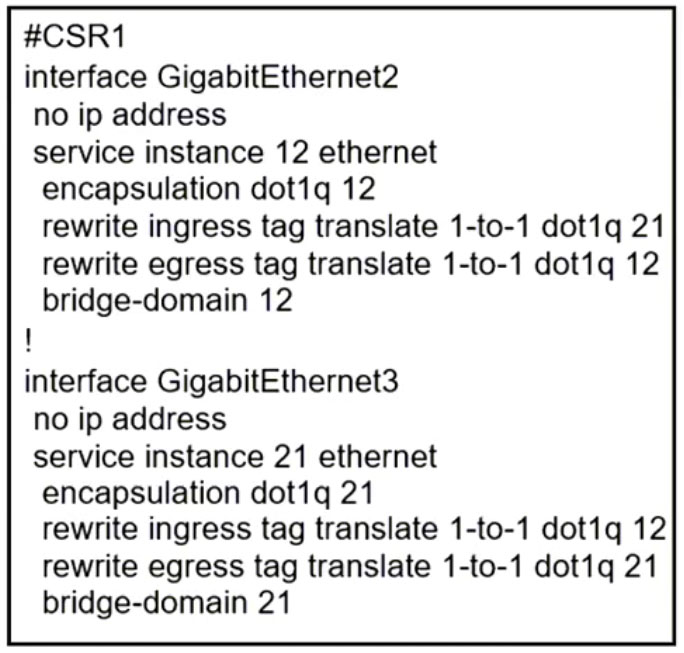
Refer to the exhibit. A network operator must configure CSR1 interfaces GigabitEthernet2 and GigabitEthernet3 to rewrite VLAN tags 12 and 21 for traffic between
R1 and R2, respectively. Which configuration accomplishes this task?
A.

B.

C.

D.


Refer to the exhibit. A network operator must configure CSR1 interfaces GigabitEthernet2 and GigabitEthernet3 to rewrite VLAN tags 12 and 21 for traffic between
R1 and R2, respectively. Which configuration accomplishes this task?
A.

B.

C.

D.

To configure CSR1 interfaces GigabitEthernet2 and GigabitEthernet3 to rewrite VLAN tags 12 and 21 for traffic between R1 and R2 respectively, it is necessary to define service instances on each interface to encapsulate the respective VLANs and rewrite the VLAN tags. Both interfaces need to be configured with the same encapsulation IDs for their respective VLANs and include the rewrite rules for ingress and egress traffic. Additionally, these service instances must be associated with a bridge domain to ensure proper VLAN bridging and forwarding between the interfaces. Therefore, the correct configuration is: interface GigabitEthernet2 no ip address service instance 12 ethernet encapsulation dot1q 12 rewrite ingress tag translate 1-to-1 dot1q 21 rewrite egress tag translate 1-to-1 dot1q 12 bridge-domain 10 ! interface GigabitEthernet3 no ip address service instance 21 ethernet encapsulation dot1q 21 rewrite ingress tag translate 1-to-1 dot1q 12 rewrite egress tag translate 1-to-1 dot1q 21 bridge-domain 10.
I think the answer is D: Bridge-Domain has to be configured with the same ID on each router.
You are right, router needs to configure interfaces for bridging with the same bridge-domain ID.
Indeed and correct tagging/rewrite config on the interfaces. Ruling out answer B.
is D A service instance must be attached to a bridge domain. Flooding and communication behavior of a bridge domain is similar to that of a VLAN domain. Bridge-domain membership is determined by which service instances have joined it, while VLAN domain membership is determined by the VLAN tag in the packet. https://www.cisco.com/c/en/us/td/docs/routers/asr920/configuration/guide/ce/b_ce_xe-313s-asr920-book/b_ce_xe-313s-asr920-book_chapter_01.html
I have tried all the options, as a case study only this option worked interface GigabitEthernet1 ======================== CSR service instance 12 ethernet encapsulation dot1q 12 rewrite ingress tag translate 1-to-1 dot1q 21 rewrite egress tag translate 1-to-1 dot1q 12 bridge-domain 10 interface GigabitEthernet2 service instance 21 ethernet encapsulation dot1q 21 rewrite ingress tag translate 1-to-1 dot1q 12 rewrite egress tag translate 1-to-1 dot1q 21 bridge-domain 10 The correct answer is D I wanted to copy all the config, the configuration was very long, the website did not let me publish it
No A is correct, you dont need Bridge-domains at all. (example found on cisco) /* TRANSLATE 1-2 */ interface TenGigE0/0/0/0.1 l2transport encapsulation dot1q 10 second-dot1q 11 rewrite ingress tag translate 1-to-2 dot1q 20 second-dot1q 30 ! ! /* TRANSLATE 2-2 */ interface TenGigE0/0/0/0.1 l2transport encapsulation dot1q 10 second-dot1q 11 rewrite ingress tag translate 2-to-2 dot1q 20 second-dot1q 30 ! ! https://www.cisco.com/c/en/us/td/docs/iosxr/ncs5500/vpn/61x/b-ncs5500-l2vpn-configuration-guide-61x/b-ncs5500-l2vpn-configuration-guide-60x_chapter_010.html#concept_49945262C5954AD08DE5E1EB823F6FC2
Your documentación is for IOS XR the CSR is XE A service instance must be attached to a bridge domain. Flooding and communication behavior of a bridge domain is similar to that of a VLAN domain. Bridge-domain membership is determined by which service instances have joined it, while VLAN domain membership is determined by the VLAN tag in the packet. https://www.cisco.com/c/en/us/td/docs/routers/asr920/configuration/guide/ce/b_ce_xe-313s-asr920-book/b_ce_xe-313s-asr920-book_chapter_01.html
I labbed this, it wouldn't work until I added the bridge-domain, I think 'D' is correct.
option D for sure!
Answer: D I have tested in GNS3 lab with IOS-XE. Without "bridge-domain 10", it doens't forward the traffic.
D is the correct one, need the bridge domain
“A service instance must be attached to a bridge domain” Something needs to link these 2 interfaces together, the rewrite Egress doesn’t put it into the local vlan database. I say the bridge domain is needed in the config. IOS-XE (CSR) guide https://www.cisco.com/c/en/us/td/docs/routers/asr920/configuration/guide/ce/17-1-1/b-ce-xe-17-1-asr920/b-ce-xe-17-1-asr920_chapter_010.pdf